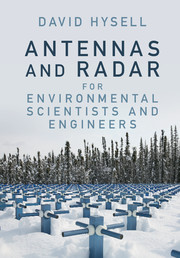Book contents
- Frontmatter
- Contents
- Preface
- 1 Introduction
- 2 Introduction to Antenna Theory
- 3 Antenna Arrays
- 4 Aperture Antennas
- 5 Noise
- 6 Scattering
- 7 Signal Processing
- 8 Pulse Compression
- 9 Propagation
- 10 Overspread Targets
- 11 Weather Radar
- 12 Radar Imaging
- Appendix A Radio Frequency Designations
- Appendix B Review of Electromagnetics
- References
- Index
- References
4 - Aperture Antennas
Published online by Cambridge University Press: 09 February 2018
- Frontmatter
- Contents
- Preface
- 1 Introduction
- 2 Introduction to Antenna Theory
- 3 Antenna Arrays
- 4 Aperture Antennas
- 5 Noise
- 6 Scattering
- 7 Signal Processing
- 8 Pulse Compression
- 9 Propagation
- 10 Overspread Targets
- 11 Weather Radar
- 12 Radar Imaging
- Appendix A Radio Frequency Designations
- Appendix B Review of Electromagnetics
- References
- Index
- References
Summary
High gain can also be achieved with the use of aperture antennas. Aperture antennas are characterized by a large collecting area, at least several wavelengths in each dimension, through which radiation passes during transmission and reception. The simplest example is an open-ended waveguide. The waveguide aperture can be flared for impedance matching purposes or the radiation can pass through tuned slots. To increase the size of the aperture, waveguides are often used in conjunction with reflectors or RF lenses, which then behave like secondary apertures. In any case, we assume the electromagnetic field across the antenna aperture is somehow known. The problem becomes one of calculating the resulting radiation fields.
Treating aperture antennas demands an appreciation of diffraction theory. Diffraction is a wave phenomenon where the rays that describe the wave deviate from rectilinear propagation paths. Ray bending can also occur in media where the index of refraction varies gradually in space. In that case, the phenomenon is called refraction. Ray bending in homogeneous media that include obstacles, including the boundaries of an aperture, is called diffraction.
The first explanation for diffraction was provided in the seventeenth century by Christian Huygens, who considered each point on a wavefront to be a kind of disturbance and a source of secondary spherical wavefronts. If the initial wavefront is an infinite plane, the superposition of all the spherical waves will be another planar wavefront, displaced from the original in the direction of propagation. If the initial wavefront has finite extent, however, the spherical waves will combine constructively in some places and destructively in others, producing an interference pattern with lobes and nulls like the radiation patterns we have already seen. Huygens’ principle can explain, for example, how radiation bends around corners and why the radiation from a finite aperture is not entirely like a “searchlight” pattern.
Throughout the eighteenth century, little attention was paid to Huygens’ principle, as the corpuscular theory of light espoused by Newton gained favor. During this time, the theory of geometric optics was developed. This theory is still used to describe refraction, and will be discussed later in the text. In the nineteenth century, however, the wave picture of light was revisited.
- Type
- Chapter
- Information
- Publisher: Cambridge University PressPrint publication year: 2018



